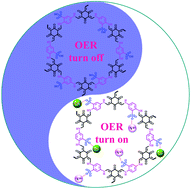Flexible and robust bimetallic covalent organic frameworks for the reversible switching of electrocatalytic oxygen evolution activity†
Abstract
Flexible and robust catalysts present a highly intriguing issue owing to their unique dynamic and reversible switching nature, which can provide a solution to maximize the atom utilization efficiency. Herein, a convenient and efficient cation-exchange strategy was developed to prepare flexible and robust Co/V-incorporated bimetallic COF electrocatalysts (namely, CoxV1−x@COF-SO3) for the oxygen evolution reaction (OER). As expected, in a 1.0 M KOH electrolyte, the optimized bimetallic Co0.5V0.5@COF-SO3 showed high turnover frequency (TOF) (0.098 s−1) at the overpotential of 300 mV, which was superior to that of most of the recently reported excellent Co-based OER electrocatalysts, exhibiting high atom utilization efficiency. Most importantly, the flexible nature of Co0.5V0.5@COF-SO3 was also observed. After treatment with hydrochloric acid, the reformation of the catalysis-inert phase of COF-SO3H was observed. This unique transformation from the catalysis-active phase of Co0.5V0.5@COF-SO3 to the catalysis-inert phase of COF-SO3H can be repeated, suggesting reversible switching of OER activity, which are almost impossible to achieve in conventional catalysts. This work provides a new concept for the fundamental design of catalysts with reversible switching properties to improve the atom utilization efficiency and simplify the procedures of catalyst regeneration.



 Please wait while we load your content...
Please wait while we load your content...